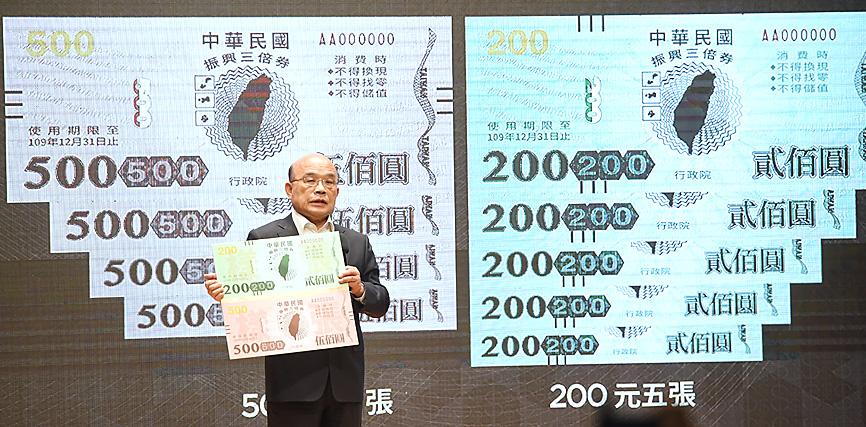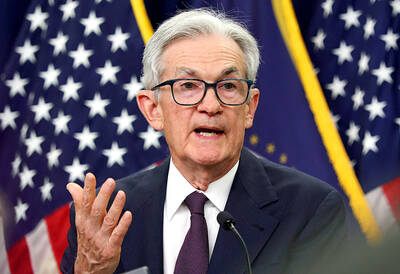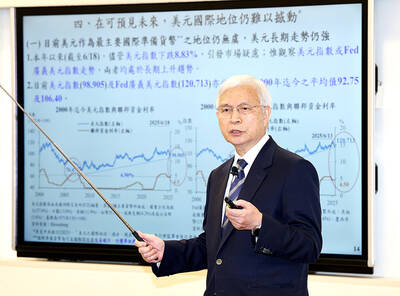The government’s Triple Stimulus Vouchers helped boost Taiwan’s retail sector last year amid the COVID-19 pandemic, the Ministry of Economic Affairs said yesterday as it unveiled the final tally for the program.
The ministry’s statistics showed that 23.32 million people in Taiwan, or 99 percent of the population, participated in the program, claiming either paper or digital vouchers.
The ministry said that 99.6 percent of the vouchers, or NT$64.28 billion (US$2.25 billion), were redeemed by vendors.

Photo: Liu Hsin-de, Taipei Times
Administration of the vouchers program, including printing and distribution, cost more than NT$2 billion, it said.
Department of Commerce Deputy Director-General Chen Mi-shun (陳秘順) said that the retail sector made a remarkable recovery after the launch of the program in the middle of July last year, which put NT$3,000 of vouchers in the pockets of eligible people.
“After five consecutive months of negative growth, the retail sector’s sales returned to positive territory in July last year, and there were record sales in the sector from August to November,” Chen said.
As the savings rate in Taiwan, is high, a cash stimulus would have gone into bank accounts or other investments, he said.
Marginalized and low-income groups received the vouchers without having to pay, he said.
“We designed the program to minimize the substitution effect and maximize the multiplication effect,” Chen said. “Once the vouchers were spent, those who received them could use them again.”
The substitution effect is when people used the vouchers on something they would have purchased without the program.
However, an informal survey showed that most used the vouchers to treat themselves.
“I got some nicer tea bags than I would have otherwise, and my boyfriend and I went out for a fancy meal,” a woman surnamed Huang (黃) said. “We were more willing to spend the vouchers.”
Others surveyed said that they took advantage of the vouchers to buy a new camera at a discount with a voucher-only deal or on convenience store gift cards.
Donovan Watson, an English teacher living in New Taipei City’s Sindian District (新店), went to Zara and bought clothing on an impulse.
Watson said that he was surprised, but appreciative that foreigners who are permanent residents were included in a later round of the program.
National Central University economist Dachran Wu (吳大任) said that the program had a positive effect and was one of the factors that helped the turnaround in the retail sector.
“After being cooped up for COVID-19 and with no way to leave the country, everybody wanted some revenge shopping,” Wu said.

DIVIDED VIEWS: Although the Fed agreed on holding rates steady, some officials see no rate cuts for this year, while 10 policymakers foresee two or more cuts There are a lot of unknowns about the outlook for the economy and interest rates, but US Federal Reserve Chair Jerome Powell signaled at least one thing seems certain: Higher prices are coming. Fed policymakers voted unanimously to hold interest rates steady at a range of 4.25 percent to 4.50 percent for a fourth straight meeting on Wednesday, as they await clarity on whether tariffs would leave a one-time or more lasting mark on inflation. Powell said it is still unclear how much of the bill would fall on the shoulders of consumers, but he expects to learn more about tariffs

Meta Platforms Inc offered US$100 million bonuses to OpenAI employees in an unsuccessful bid to poach the ChatGPT maker’s talent and strengthen its own generative artificial intelligence (AI) teams, OpenAI CEO Sam Altman has said. Facebook’s parent company — a competitor of OpenAI — also offered “giant” annual salaries exceeding US$100 million to OpenAI staffers, Altman said in an interview on the Uncapped with Jack Altman podcast released on Tuesday. “It is crazy,” Sam Altman told his brother Jack in the interview. “I’m really happy that at least so far none of our best people have decided to take them

PLANS: MSI is also planning to upgrade its service center in the Netherlands Micro-Star International Co (MSI, 微星) yesterday said it plans to set up a server assembly line at its Poland service center this year at the earliest. The computer and peripherals manufacturer expects that the new server assembly line would shorten transportation times in shipments to European countries, a company spokesperson told the Taipei Times by telephone. MSI manufactures motherboards, graphics cards, notebook computers, servers, optical storage devices and communication devices. The company operates plants in Taiwan and China, and runs a global network of service centers. The company is also considering upgrading its service center in the Netherlands into a

NOT JUSTIFIED: The bank’s governor said there would only be a rate cut if inflation falls below 1.5% and economic conditions deteriorate, which have not been detected The central bank yesterday kept its key interest rates unchanged for a fifth consecutive quarter, aligning with market expectations, while slightly lowering its inflation outlook amid signs of cooling price pressures. The move came after the US Federal Reserve held rates steady overnight, despite pressure from US President Donald Trump to cut borrowing costs. Central bank board members unanimously voted to maintain the discount rate at 2 percent, the secured loan rate at 2.375 percent and the overnight lending rate at 4.25 percent. “We consider the policy decision appropriate, although it suggests tightening leaning after factoring in slackening inflation and stable GDP growth,”